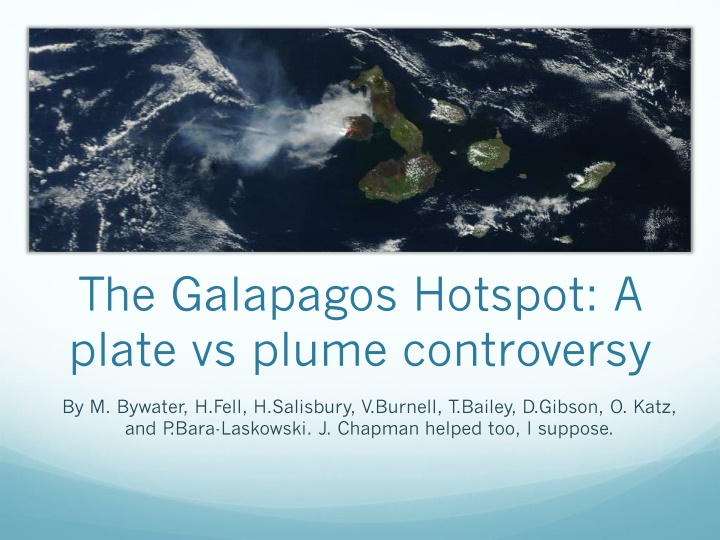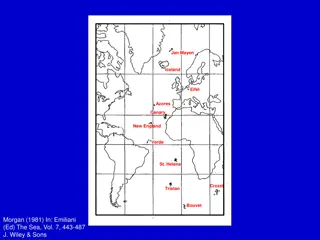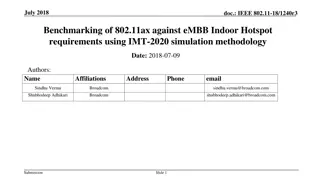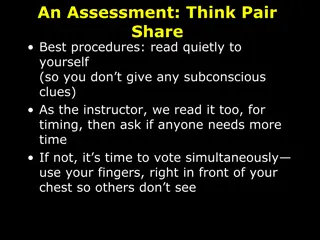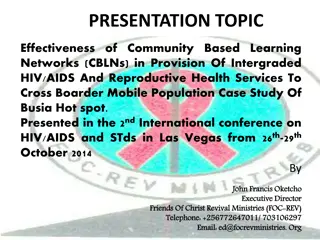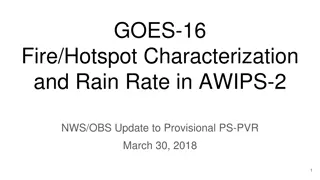Debunking the Galapagos Hotspot: Plate vs. Plume Controversy
Situated in the Pacific Ocean, the Galapagos Islands have sparked a debate on whether they were formed by mantle plumes or the spreading ridge. Evidence refuting the plume theory includes variations in isotopic compositions, non-progressive volcanic activity, unique morphology, seismic findings, and geochemical interactions. This comprehensive analysis challenges the traditional view of hotspot formation, shedding light on complex earth processes at play in the Galapagos region.
Uploaded on Sep 24, 2024 | 4 Views
Download Presentation

Please find below an Image/Link to download the presentation.
The content on the website is provided AS IS for your information and personal use only. It may not be sold, licensed, or shared on other websites without obtaining consent from the author.If you encounter any issues during the download, it is possible that the publisher has removed the file from their server.
You are allowed to download the files provided on this website for personal or commercial use, subject to the condition that they are used lawfully. All files are the property of their respective owners.
The content on the website is provided AS IS for your information and personal use only. It may not be sold, licensed, or shared on other websites without obtaining consent from the author.
E N D
Presentation Transcript
The Galapagos Hotspot: A plate vs plume controversy By M. Bywater, H.Fell, H.Salisbury, V.Burnell, T.Bailey, D.Gibson, O. Katz, and P .Bara-Laskowski. J. Chapman helped too, I suppose.
Introduction Situated in the Pacific Ocean, roughly 600 miles off the west coast of Ecuador. The Galapagos Spreading Centre (GSC) is between the Nazca and Cocos plates. An issue of debate as to whether the Islands were created by Mantle Plumes or from the proximal spreading ridge. Fig. 2. Map from Geist and Harpp (2003)
Disproving the Plume: Time Progression and Isotopic Variations Volcanism is not strictly time progressive in the direction of plate motion. Most of the volcanoes still active, regardless of location within island chain. Galapagos lavas have a wider range of isotope compositions than is the norm. (Harpp and Geist, 1998) Central-most islands have composition similar to MORBs.
Disproving the Plume: Morphology There are volcanoes along hotspot traces that are significantly younger than the area of ridge they occur on (e.g. Cocos Island). If this were a plume in a fixed position, these should not appear; the plate should have moved past, leaving these areas relatively cool. Doesn t have the typical morphology of a mantle plume structure; no dome shape. Fig. 6: There seem to be two separate directions of volcano alignment, neither of which are derived from directions of plate motion or spreading.
Seismology and Temperature Typically, isolated gravity highs are found over other hot spots, but none are seen in the Galapagos. Although seismic evidence of plumes in the upper mantle is accumulating3, narrow plume conduits in the deep mantle have yet to be detected. (Helmsberger et al 1998) The magmas over the hotspot are not actually hot enough, being 50-100 degrees cooler than Hawaii. (Although this could be due to loss of heat in the thicker upper lithosphere.)
Disproving tectonics: Geochemistry Magmatic 3He/4He values reach up to 26 times higher than atm concentrations at Fernandina, which is the most active volcano, and on the edge of plate motion = likely a plume centred beneath this island. Samples collected from seamounts along the Cocos and Carnegie ridges show basalt compositions ranging from alkali to tholeiitic. These values are close to OIB values, as opposed to MORB being exclusively tholeiitic, and so suggests a plume interaction along these potential hotspot tracks. (Kurz and Geist, 1999)
Disproving tectonics: Isotope Variation Large range of isotopes present due to heterogeneous mixing of plume magma, and less so due to near-surface depletion. Horseshoe pattern of plume magma in north, south and west believed to come from toroidal mechanisms. Is actually more likely due to a bent magma plume via sub- surface currents. (Griffiths, 1989). Fig. 7: Current models of Galapagos isotope and bent plume hypothesis (Harpp and White, 2001)
Disproving tectonics: Seamounts and Seismology Seismic imaging of core-mantle boundary under Cocos plate shows a 100-km vertical step occurring in an otherwise flat D" shear velocity discontinuity (Thomas et al., 2004, Hutko et al., 2006, Kito et al., 2007) S-wave arrival time tomography indicates a steeply- dipping, sharply- bounded slow zone (anomalies of about -2% relative to PREM) extending to at least 400 km depth. Seamount data shows a (generally) quadratic relationship in comparison of age to elevation along the Cocos Ridge, suggesting plate movement over a fixed hotspot. Fig 9: Seismic survey showing deep shear velocity discontinuity (Thomas et al) Fig 10: Seamount and island data.
Conclusions There is widespread evidence to back up both hypotheses, which is open to multiple interpretations. Many features aren t possible without a deep mantle source. However, proximity to the GSC clearly influences composition of magma and island s morphology. Suggested work Find further seismic data for greater depths in order to chart depth of discontinuity to C-M boundary. Isotopic data from individual volcanoes can be used to create better plume models. Investigate potential dual plume theory.
